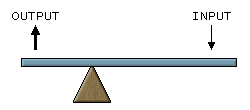Lever facts for kids
Quick facts for kids Lever |
|
|---|---|

Levers can be used to exert a large force over a small distance at one end by exerting only a small force (effort) over a greater distance at the other.
|
|
| Classification | Simple machine |
| Components | fulcrum or pivot, load and effort |
| Examples | see-saw, bottle opener, etc. |
A lever is a simple machine. It is a strong bar or beam that rests on a special point called a fulcrum. Think of it like a seesaw!
Levers help us move heavy things or apply a lot of force with less effort. They are one of the six basic simple machines that make work easier. There are three main types of levers, and they are different based on where the fulcrum, the load, and the effort are placed.
Contents
Levers in History
People have known about levers for a very long time! The first writings we have about them are from the 3rd century BC. A famous Greek scientist named Archimedes wrote about how levers work. He even said, "Give me a place to stand, and I shall move the earth." This shows how powerful he knew levers could be!
How Levers Work
Every lever has three important parts:
- The fulcrum is the pivot point where the lever rests. It's like the middle part of a seesaw.
- The load is the object or weight you want to move.
- The effort is the force you apply to the lever to move the load.
The way these three parts are arranged tells you what type of lever it is.
Types of Levers
There are three main types, or classes, of levers. They are different because of where the fulcrum, the load, and the effort are located on the bar.
First-Class Levers
In a first-class lever, the fulcrum is always in the middle. It is placed between the effort you apply and the load you want to move.
- Example: A seesaw is a perfect example. The middle support is the fulcrum. You push down on one end (effort), and your friend goes up on the other (load). A crowbar used to lift something is another example.
Second-Class Levers
In a second-class lever, the load is in the middle. It is located between the fulcrum and where you apply the effort.
- Example: A wheelbarrow is a great example. The wheel is the fulcrum. The heavy stuff in the wheelbarrow is the load. You lift the handles (effort) to move it. A bottle opener is also a second-class lever.
Third-Class Levers
In a third-class lever, the effort is in the middle. You apply your force between the fulcrum and the load.
- Example: A stapler is a common third-class lever. The hinge at the back is the fulcrum. You press down in the middle (effort), and the staple pushes through the paper at the front (load). Your forearm when you lift something is also a third-class lever! Your elbow is the fulcrum, your bicep muscle applies the effort in the middle, and the weight you lift is the load in your hand.
Images for kids
See also
 In Spanish: Palanca para niños
In Spanish: Palanca para niños







